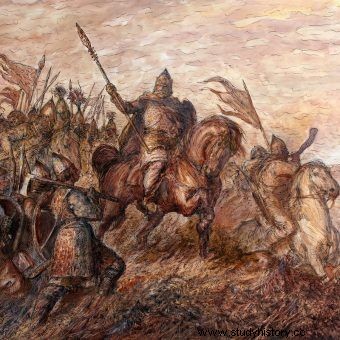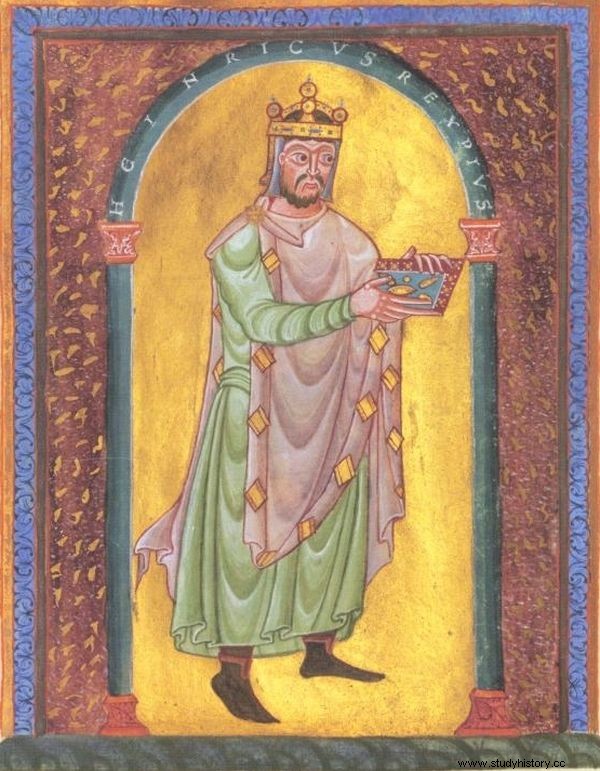The Ruthenians trembled at his power. The Germans had greater respect for him than for any other leader. The Vikings were afraid to meet him on the battlefield. Why were his warriors invincible?
The team and the prince were like two halves of one fruit. The prince organized expeditions from which loot and slaves were brought, thanks to which he had the means to support his warriors. In a way, military expeditions were a necessity. As the Hungarian historian György Györffy wrote:
Maintaining power always depends on whether the ruler is able to meet the material requirements of his party and ensure his fidelity through constant benefits. If the prince has no income to pay his wages and support the army, and he cannot organize loot-laden expeditions, his warriors will either turn their backs on him or rise up in rebellion.

Bolesław Chrobry with the team during the expedition to Kyiv. Drawing by Karol Stobiecki.
It's just that a similar model as in Poland was in force, inter alia, in the Czech Republic or Hungary, and it was Bolesław who overshadowed all his neighbors with the scale of his activities. The list of conquests of the first king of Poland may be impressive. Moravia with Olomouc, the Czech Republic with Prague, Lusatia, Meissen, Kyiv, the lands of several Prussian tribes, the territory of today's Slovakia, the mysterious land of Selencja ...
If you don't listen, you will die miserably
Chrobry paid well, but also required obedience. Poles were punitive warriors. As Andrzej Nadolski emphasized in his book on the military of Bolesław's time:
The sources did not give us any news about breaking the discipline in Brave's Polish army, but clearly mention that the German army at that time was far from the desired discipline .

Chrobry cared for his warriors, but in return he demanded absolute loyalty. The illustration shows a painting by Michał Bylina entitled "Team of Bolesławów".
Anyway, they would only try ... In 1013, Bolesław organized an expedition to Ruthenia, supported by warriors from the nomadic Pecheneg people. The latter turned out to be wayward. The Polish ruler, regardless of the consequences, attacked and murdered his own allies!
At the same time, Bolesław did not lavish blood on loyal people - quite the opposite. When he saw no chance of victory, he withdrew and avoided open battle. This was the case in 1004, when he fled Prague when he heard about the approaching German army; this was the case during the war with the Reich in 1005, when he was moving back to Poznań, and at the turn of 1018 and 1019, when he evacuated from Kiev. As Andrzej Nadolski rightly noted:
Brave's troops retreated frequently. However, as it can be assumed, the Polish armed forces never disintegrated, never turned into a total disaster. As a rule, after some time, the enemy pursuing them encountered reorganized resistance.
It sometimes happened that Bolesław's warriors were eager to fight, but they were stopped by a ducal order. In 1010, the German king Henry II entered Poland, and Bolesław watched the burning towns and villages from the ramparts of Głogów. The commanders urged the ruler to face the invaders in the open field, but Chrobry remained adamant.
He was afraid of the unnecessary slaughter of his people. Although the Germans, laden with loot, returned to the Reich, the prince kept his warriors alive and soon used the opportunity to take bloody revenge on the aggressors.
Smarter with each trip
The closest to breaking Bolesław's power was the aforementioned German ruler Henry II. He organized his first expedition to Poland in February 1004. Winter was an unusual time for this type of action, usually the "war season" started in late summer. By the way, the Byzantine military treaties advised that the Slavs should be attacked in winter, when they could not hide behind the forest foliage, and the snow made it easier to pursue refugees.

Henry II was closest to definitively defeating Brave. Ultimately, however, it was Bolesław who emerged victorious from many years of struggle.
However, great snowfalls, followed by a sudden thaw, were effectively grounded by German troops. It was impossible to wade through the snowdrifts first and then the slush mounds.
From then on, Henry II attacked Poland in the summer or early autumn, each time with a deteriorating effect. When in 1015 he divided his forces into four armies, Bolesław blocked two, stopped the third with a subversive attack on Austria, and chased the fourth into the marshes and brought it a bloody end.
Two years later, in 1017, the German ruler no longer shared his forces. However, he got stuck near Niemcza. The chronicler Thietmar, relying on eyewitness accounts, wrote that:
The emperor ordered us to build various types of siege machines, but soon they appeared very similar to them on the enemy. I have never heard of the besieged, who would increase their perseverance and more prudent resourcefulness to seek their defense. [...] When something fortunate happened to them, they never shouted out with joy, but neither did they reveal their failures through effusive complaints.

Even though Henry II drew conclusions from his defeats, in 1017 at Niemcza he once again had to swallow the bitterness of defeat.
After three weeks, Henry II ordered Germany to be stormed, but the siege machines built with great difficulty "quickly burned down from the fire thrown from the ramparts". Attempts to climb the ramparts ended in failure. In the end, the defeated emperor had to turn back.
A trick worthy of Mr. Zagloba
Bolesław sometimes used stratagems worthy of Mr. Zagloba from Sienkiewicz. Despite the good orientation in the field of the people of that era, medieval armies had to use the services of local guides. In 1005, Chrobry bribed people who were to lead the German army through the area between the Elbe and the Oder. As a result, instead of the shortest route, Henry's warriors marched several days through the swamps and wastelands.
The prince also cared for communication between his divisions. The couriers swung from one to the other in a flash. Most of the information they had to memorize, sometimes the figures were punched on the sticks.

Chrobry was a master of tricks. He was able to surprise the enemy at the moment least expected for him. The illustration shows the nineteenth-century image of the Brave team in action.
He could also surprise his enemies with a sudden blow. This is largely due to the Polish horses - maybe they didn't look too impressive, but they had other advantages:
Especially in poor communication conditions, the horses show high utility values. Their ability to "walk" on soggy ground is sometimes emphasized, especially in the period of thaw.
Well, sir, in politics?
War, says Clausewitz, is a continuation of politics. Bolesław Chrobry was a perfectionist in this respect. If there were political turmoil in any of the neighboring countries of Poland, Piast warriors immediately appeared and took over new lands, often without bloodshed.
At the news of the death of his friend, Emperor Otto III, the Polish prince burst into tears, but then entered the Reich, taking Lusatia and Meissen under his rule. There was no battle and bloody fights, and the German mighty from Lusatia paid tribute to the Polish prince themselves.
It was similar with the occupation of Prague. Chrobry had destabilized the Czech political scene earlier - he first placed his cruel cousin Bolesław III the Red on the throne there. When the latter ventured into murdering his opponents, he tricked him, blinded him, and took his place as the last righteous one.
In the historical consciousness - also driven by propaganda seeking justification for the western borders of 1945 - Bolesław the Brave functions as the one who fought the German element for years. Yes, he fought with the German king, but at the same time the first king of Poland was an extremely flexible politician. When he attacked Rus - whether in 1013 or 1018 - he was always supported by reinforcements sent by Henry II.
Bolesław was able to look for allies literally everywhere, even contacting Italian magnates and Luxembourg counts.
Unknown Heroes
Already about the armored wars of his father, Mieszko I, it was said that "a hundred of them means as much as ten hundred other warriors". The people of Bolesław the Brave had to stand out in the fight - morale among Polish warriors was certainly high. However, the names of the commanders from the turn of the 10th and 11th centuries were lost forever. It is only thanks to foreign messages that we know that among Mieszko's son's subordinates were the Czech prince Sobiesław - the brother of Saint Adalbert, the German knight Eryk, and - although his profession is debatable - a certain Stoigniew, who twice sent to the Reich on behalf of Brave.

The memory of the deeds of Brave and his team has survived for 1000 years. The illustration shows the portrait of the ruler by Marcello Bacciarelli.
Only the image of the nameless several thousand warriors, armed mainly with spears, axes and bows, less often with expensive swords, who under the leadership of the charismatic Bolesław the Brave did extraordinary things, the memory of which lasted a thousand years. The first king of Poland was a conqueror that never happened again in the Piast family. And there is no exaggeration in that.
"For who can worthily recount his brave deeds and battles with the surrounding nations, and what only in writing can they pass them to memory?" Asked Anonymous called Gall rhetorically. Admittedly, under the pen of this chronicler, Chrobry is overly idealized, but in the case of military successes, we can partially verify Gall's data based on older, foreign sources. And every time we say 'Checking' on the card table, Gall turns out to be absolutely right. Chrobry was a genius of war.
Selected bibliography:
Sources:
- Anonymous Gall, Polish Chronicle , crowd. Roman Grodecki, ed. Marian Plezia, pub. 7, Wroclaw - Warsaw - Krakow 1999.
- The Chronicle of Thietmar , pub. and crowd. Marian Zygmunt Jedlicki, Poznań 1953.
Studies:
- Barnat Roman, The armed forces of Bolesław the Brave in the light of Gallus Anonymus's account , "Przegląd Historyczny", 88, 1997, 2.
- Grabski Andrzej F., Bolesław the Brave. Outline of political and military history , Warsaw 1964.
- Györffy György, Saint Stephen I, King of Hungary , crowd. Tomasz Kapturkiewicz, Warsaw 2003.
- Łowmiański Henryk, The beginnings of Poland , Warsaw, vol. 5, Warsaw 1973; vol. 6 part. 1, Warsaw 1985.
- Morys-Twarowski Michael, The birth of power. All the conquests of Bolesław the Brave , Krakow 2017.
- Nadolski Andrzej, Polish armed forces in the times of Bolesław the Brave. Outline of strategy and tactics , Łódź 1956.
